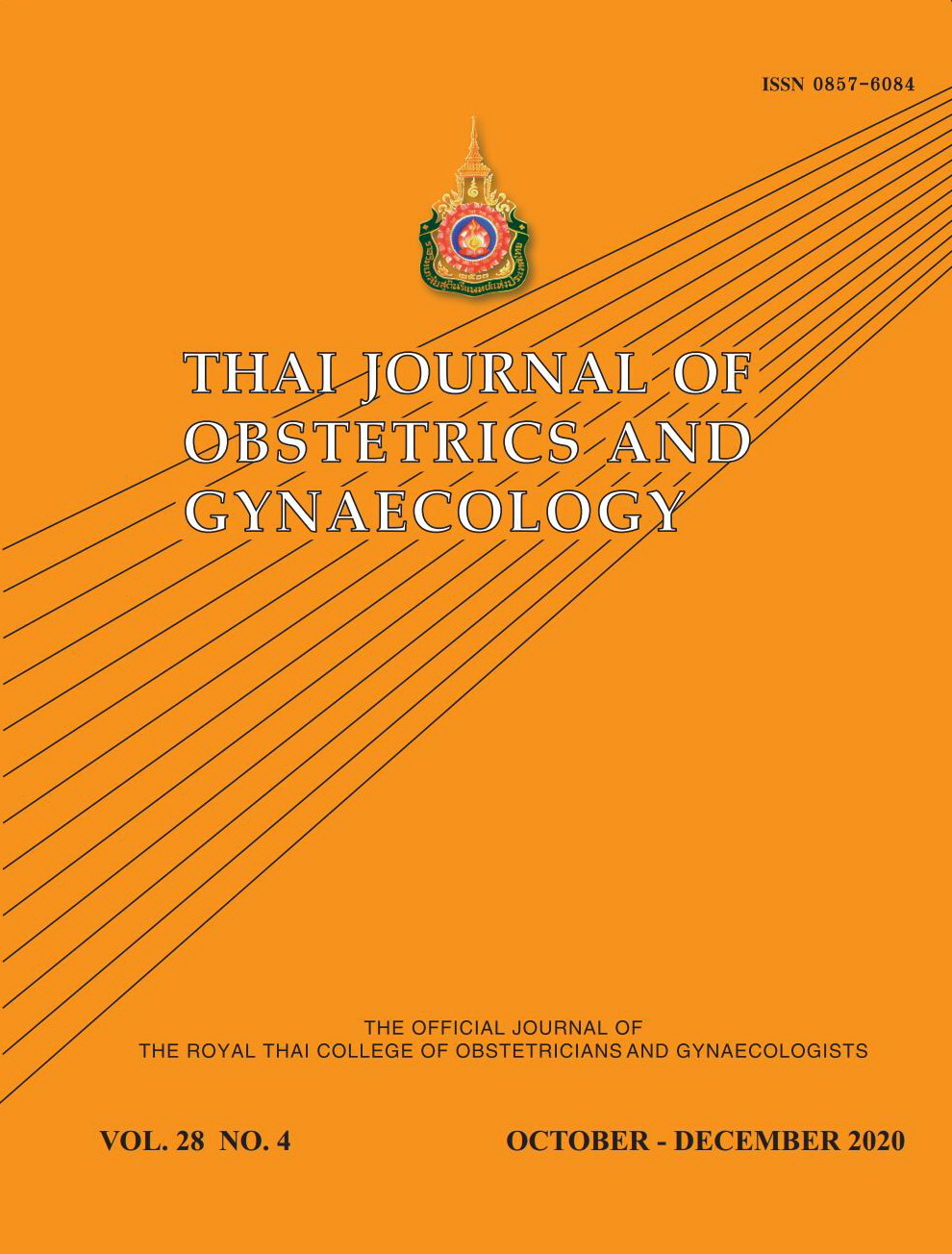Prediction of Successful outcome of Labor Induction at Term by Transvaginal Sonographic Assessment of Cervical Length
Main Article Content
Abstract
Objectives: To examine transvaginal sonography assessment of cervical length (TVSCL) as a predictor of active phase of labor, successful vaginal delivery after labor induction, and to estimate the most useful cutoff point for cervical length (CL).
Materials and Methods: A prospective cohort study was conducted in the Obstetrics and Gynecology Department of Phramongkutklao Hospital. Pre-induction cervical assessment was undertaken in 120 women with singleton pregnancy at 37–42 weeks of gestation who underwent induction of labor. All women were measured for CL using transvaginal sonography followed by pelvic examination for Bishop score (BS) assessment.
Results: Successful induction of labor to active phase within 24 hours occurred in 84.1% of the subjects. The best cut-off point of CL for the prediction of successful labor induction to active phase within 24 hours was found to be 3.14 cm or less with a sensitivity of 73.3 %, a specificity of 78.9 %, as well as negative and positive predictive values of 35.7% and 94.9%, respectively. In addition, a 3.14 cm or less cut off point of CL can be used to predict successful vaginal delivery with a
Conclusion: TVSCL was significantly associated with successful induction of labor to active phase within 24 hours and can be used as a predictor for successful induction to vaginal delivery with a 3.14 cm or less cutoff point of CL.
Article Details
References
The Royal College of Obstetricians and Gynaecologists (RCOG). Induction of labor. NICE clinical guideline 70. London: National Institute for Health and Clinical Excellence 2008.
Cole RA, Howie PW, Magnaughton MC. Elective induction of labour. A randomized prospective trial. Lancet 1975;1:767-70.
Sande HA, Tuveng J, Fonstelien T. A prospective randomized study of induction of labor. Int J Gynaecol Obstet 1983;21:333-6.
Sue-A-Quan AK, Hannah ME, Cohen MM, Foster GA, Liston RM. Effect of labour induction on rates of stillbirth and cesarean section in post-term pregnancies. CMAJ 1999;160:1145-9.
ACOG Committee on Practice Bulletins - Obstetrics. ACOG Practice Bulletin No. 107. Induction of labor. Obstet Gynecol 2009;114:386-97.
Bishop EH. Pelvic scoring for elective induction. Obstet Gynecol 1964;24:266-8.
Hendrix NW, Chauhan SP, Morrison JC, Magann EF, Martin JN Jr., Devoe LD. BS: a poor diagnostic test to predict failed induction versus vaginal delivery. South Med J 1998;91:248-52.
Roman H, Verspyck E, Vercoustre L, Degre S, Col JY, Firmin JM, et al. Does ultrasound examination when the cervix is unfavorable improve the prediction of failed labor induction. Ultrasound Obstet Gynecol 2004;23: 357-62.
Lams JD, Paraskos J, Landon MB, Teteris JN, Johnson FF. Cervical sonography in preterm labor. Obstet Gynecol 1994;84:40-6.
Jackson GM, Ludmir J, Bader TJ. The accuracy of digital examination and ultrasound in the evaluation of cervical length. Obstet Gynecol 1992;79:214-8.
Verhoeven CJ, Opmeer BC, Oei SG, Latour V, van der Post JA, Mol BW. Transvaginal sonographic assessment of CL and wedging for predicting outcome of labor induction at term: a systematic review and meta-analysis. Ultrasound Obstet Gynecol 2013;42:500-8.
Kaoian V, Luangdansakul W, Wacharasint P. Transvaginal sonographic CL versus BS in labor induction to predict the risk of cesarean delivery: a comparison study. J Med Assoc Thai 2018;101:157-61.
Cunningham FG, Leveno KJ, Bloom SL, Hauth JC, Gilstrap III LC, Wenstrom KD, et al. Williams Obstetrics. 25nd ed. New York: McGraw-Hill 2018:421-40.
Fetalmedicine.org [Internet]. London: Cervical assessment; 2016 [cited 2016 November 05]. Available from: https://fetalmedicine.org/training-n-certification/certificates-of- competence/cervical-assessment-1.
Yang SH, Roh CR, Kim JH. Transvaginal ultrasonography for cervical assessment before induction of labor. J Ultrasound Med 2004;23:375-82.
Khandelwal R, Patel P, Pitre D, Sheth T, Maitra N. Comparison of CL measured by transvaginal ultrasonography and BS in predicting response to labor induction. J Obstet Gynaecol India 2018;68:51-7.
Park KH, Kim SN, Lee SY, Jeong EH, Jung HJ, Oh KJ. Comparison between sonographic CL and BS in preinduction cervical assessment: a randomized trial. Ultrasound Obstet Gynecol 2011;38:198-204.
Pandis GK, Papageorghiou AT, Ramanathan VG, Thompson MO, Nicolaides KH. Preinduction sonographic measurement of CL in the prediction of successful induction of labor. Ultrasound Obstet Gynecol 2001;18:623-8.
Daskalakis G, Thomakos N, Hatziioannou L, Mesogitis S, Papantoniou N, Antsaklis A. Sonographic CL measurement before labor induction in term nulliparous women. Fetal Diagn Ther 2006;21:34-8.
Hatfield AS, Sanchez-Ramos L, Kaynitz AM. Sonographic cervical assessment to predict the success of labor induction: a systematic review with meta-analysis: Am J Obstet Gynecol 2007;197:186-92.
Gonen R, Degani S, Ron A. Prediction of successful induction of labor: comparison of transvaginal ultrasonography and the BS. Eur J Ultrasound 1998;7: 183-7.
Khazardoost S, Ghotbizadeh F, Latif S, Tahani M, Rezaei MA, Shafaat M. The Predictive Value of Trans-Vaginal Ultrasound Measurements Compared with Bishop Score in Determining Successful Induction of Labor. J Obstet Gynecol Cancer Res 2016;1:e8259.
Park KH, Hong JS, Kang WS, Shin DM, Kim SN. Body mass index, Bishop score, and sonographic measurement of the cervical length as predictors of successful labor induction in twin gestations. J Perinat Med 2009;37: 519-23.


